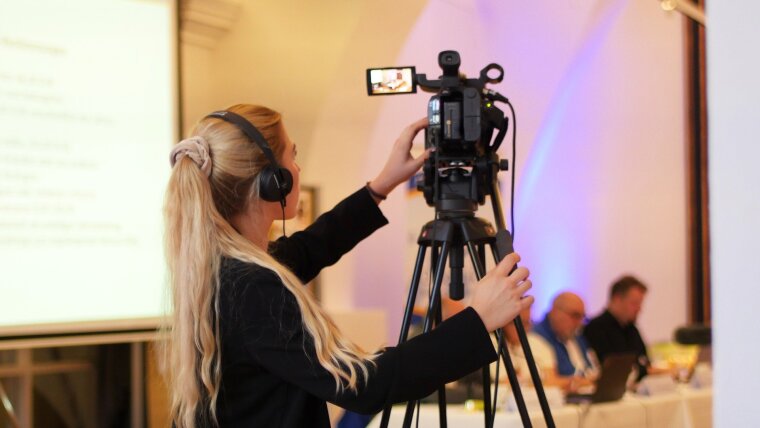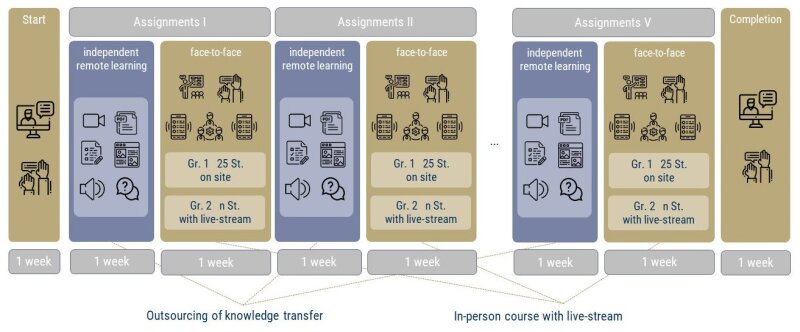
Symbolbild für Videoübertragung
Overview
This scenario demonstrates how interactive elements can be incorporated even when teaching big groups. The goal is to support a deepening of knowledge and to create a space for questions arising in students and to clarify these together. In our example, periods of independent online-learning and in-person-phases that are broadcast live to students not present alternate within the context of different assignment packages.
Start: In-person with live-stream:
- Takes place synchronously, some of the students are present in-person, others participate via live stream (refer to MMZ services de)
- Determination of students’ level of knowledge and competence: e.g. assessing prior knowledge via an audience-response-system (e.g. pingoExternal link), both students present in-person and students following the live stream participate in these quizzes.
- Introduction to ways of working: course concept and structure
- Making students’ expectations transparent: which learning objectives are you pursuing in this course? How can/should students participate? What is due to be prepared for individual sessions? When, how, and on basis of which criteria is performance assessed and marked? How and where can the backed-up contents of the course be accessed? How can technical difficulties be dealt with?
- Thematic introduction: Content schedule and central idea of the course; arouse interest in the topic, e.g. via the usage of case studies/examples, through referencing your discipline’s challenges, making connections to students’ everyday environment; linking to and going beyond students’ points of prior knowledge e.a.
Task Package I-IV: Independent online learning and periods of in-person-attendance
- In our example, each package consists of an online-self-study-period and an in-person-session that is being streamed in real-time
- Independent online-learning period:
- Students acquire new knowledge, actively digest it and/or solve problem.
- This process could be based on recorded input, screencasts, self-study-videos, scripts or texts.
- As part of this process, questions could be gathered which subsequently can be addressed at the in-person-session. A task for the students might be for example to form at least one question after working with a video or a task (e.g. in moodleExternal link, PadletExternal link, or Tweedback ChatwallExternal link).
- In-person group session with live-stream:
- Selected questions/aspects to discuss that students have come up with as a result of their independent online learning can be addressed
- Short inputs by the lecturer are well suited to utilize these questions as springboards to deepen or widen knowledge
- In order to gain an insight into students’ level of knowledge/ to give students an opportunity to self-assess, small tasks are apt: Their results can be gathered and compared in audience-response-tools like PingoExternal link. Unanswered questions can be asked via Tweedback ChatwallExternal link stellen.
- Organisational Challenges:It is possible that not all students are able to follow the live-stream, e.g. because their internet connection is insufficiently stable. Possible solution: Upload a recording of the session, especially of the sequences where exam-relevant knowledge is being presented. Since only a limited number of people is allowed to be present at the in-person-session due to the Covid-19-guidelines, pre-registration for the in-person-session is advisable, e.g. via Vote in moodle or the DFN-plannerExternal link.
Conclusion - In-person-session with live-stream
- takes place synchronously, duration: ca 90mins, part of the students is present in-person, the others participate via the live-stream
- Thematic conclusion of the course, e.g. through a weaving together of the insights gained across the individual task packages
- Discussion of questions that have arisen across the different assignment packages
- Taking stock of acquired knowledge e.g. via mapping it out, for example with PadletExternal link)
- Tune in on upcoming assessments/exams: Sharing information on assessment modalities; giving insight into helpful exam preparation strategies and making the assessment criteria transparent; if applicable: Working on practice questions and subsequently clarifying questions arising during this process.
